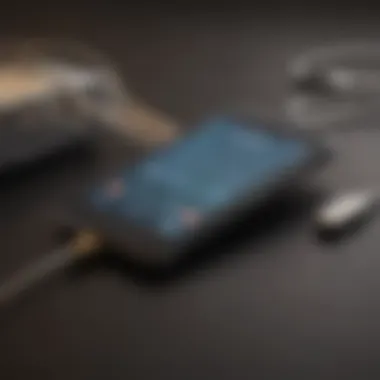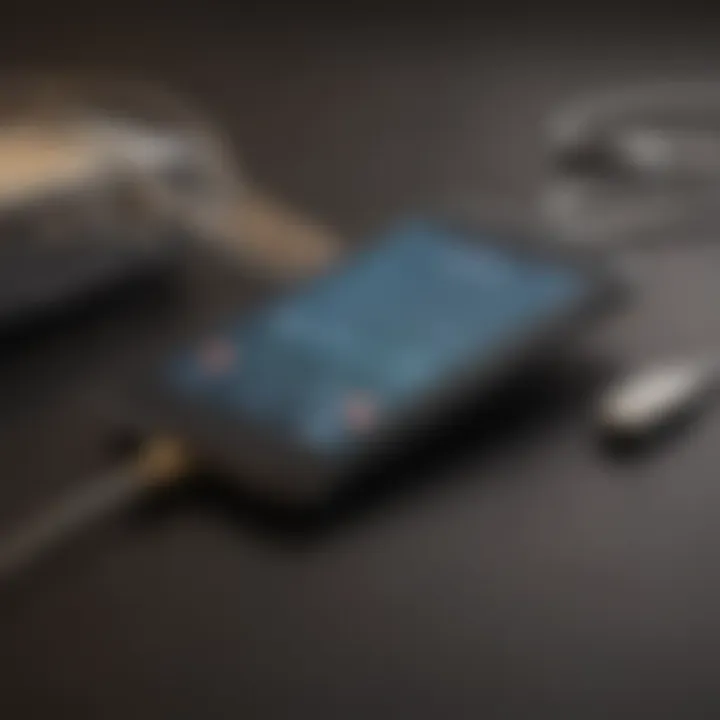Understanding Wire Transfers: Phone Transactions Explained


Intro
Wire transfers are a common method of moving money, in today’s digital and interconnected world. While many are familiar with the online options available, fewer understand the nuances of conducting such transactions over the phone. This method, though less common, can still be a useful tool for those who prefer to avoid technology or may not have internet access.
Understanding wire transfers involves knowing how they work, what technology is essential, and the security aspects that come into play when transactions occur via phone communication. This guide aims to delve into these topics, providing a comprehensive understanding of the process and its implications.
Overview of Wire Transfers via Phone
The essence of wire transfers is straightforward: moving funds from one account to another. When conducted over the phone, the process can become more involved due to the necessity for personal verification and communication with banking representatives. This overview highlights key aspects of phone-based wire transfers.
Communication Channels
Primarily, phone transfers require clear communication with your bank. Customers usually need to call the bank’s dedicated wire transfer service or customer support line. In doing so, they may be asked to provide sensitive information to authenticate their identity before the transaction can be processed.
Technological Requirements
To initiate a wire transfer over the phone, certain information is crucial:
- Account Numbers: Both sender and receiver must provide their respective bank account numbers.
- Routing Numbers: This identifies the financial institution involved in the transaction.
- Personal Identification: Often, the bank will require personal identification details as part of their security measures.
Security Concerns
Security is paramount in wire transfers, especially when done via phone. The risk of providing sensitive information over the phone is significant. Customers should ensure they only communicate with verifiable bank representatives. Using secure lines or confirmed numbers can mitigate some risks; still, one should always approach phone transactions with caution.
Best Practices for Phone-Based Wire Transfers
To maximize the security and efficiency of wire transfers conducted over the phone, consider these strategies:
- Verify Contact Information: Always ensure you are calling the correct bank number. Look for numbers on official documents or the bank's website.
- Limit the Disclosure of Information: Only provide the necessary details, and be cautious when discussing sensitive information.
- Confirm Details Before Finalizing: Before completing the transfer, double-check the details with the bank representative.
Final Thoughts
As we explore more in-depth aspects of wire transfers conducted over the phone, we encourage readers to weigh the benefits against the potential risks. The convenience of phone transactions can be appealing but must be balanced with careful attention to security. Keeping these factors in mind will lead to safer and smoother transactions.
Prelims to Wire Transfers
Wire transfers serve as a crucial element in modern financial transactions. Their role cannot be understated, especially in a global economy where speed and convenience are paramount. It is essential to understand what wire transfers are, the technology behind them, and how they fit into our daily monetary practices.
This article aims to demystify wire transfers, particularly focusing on the notion of executing them over the phone. The discussion goes beyond mere definitions. It delves into the history, mechanics, and evolving trends of wire transfers in a digital age. By grasping the foundational aspects of wire transfers, readers gain insights into their functionality, advantages, and the considerations necessary for safe execution.
Definition and Purpose
A wire transfer is essentially an electronic method of transferring funds between people or institutions. This involves intermediary banks or financial institutions allowing the sender to instruct the transfer directly through their systems. The purpose is clear: facilitate immediate and secure movement of money, whether domestically or internationally.
Wire transfers eliminate many pitfalls associated with traditional forms of payment, such as checks. They offer reliability and speed that are indispensable in urgent financial situations. Knowing how they operate helps individuals and businesses make informed decisions regarding money transfer options.
History of Wire Transfers
The concept of wire transfers is not new. It dates back to the mid-19th century with the advent of the telegraph. This technology allowed for messages to travel quickly, which in turn facilitated communication about financial transactions. The first commercial wire transfer system appeared in the 1870s by Western Union, establishing a framework for modern transfers. Over decades, different banking systems worldwide refined and adapted the method, ultimately merging into electronic and digital formats we utilize today.
Understanding this progression illustrates how the financial landscape has adapted to technological advancements. As we explore the current processes, one can appreciate the evolution and sophistication that led to wire transfers being a mainstay in monetary dealings. By grasping this historical context, readers can better understand its current relevance and future trajectory in an increasingly digital economy.
The Mechanics of Sending Money
Understanding the mechanics of sending money through wire transfers is crucial for anyone navigating the financial landscape today. This section will explain how wire transfers operate and the types available. Knowing these details helps ensure informed decision-making during monetary transactions, especially when utilizing phone services.
How Wire Transfers Work
Wire transfers utilize a secure electronic network to move funds from one financial institution to another. The process usually involves several steps:
- Initiation: The sender contacts their bank, either through a visit, online interface, or phone call. They provide necessary information like the recipient's name, bank details, and amount to send.
- Verification: The bank verifies the sender's identity and ensures they have sufficient funds.
- Transmission: The bank sends the payment request through a wire transfer network such as SWIFT or ACH, depending on the transaction type.
- Completion: The receiving bank processes the payment and credits the funds to the recipient's account.
This simplicity belies a complex infrastructure designed to speed up and secure transactions. Speed and accuracy are significant benefits in wire transfers, especially for high-value transactions.


Types of Wire Transfers
Wire transfers are broadly categorized into two types: domestic and international. Each has distinct characteristics and advantages, crucial for different circumstances.
Domestic Wire Transfers
Domestic wire transfers involve transactions within a single country. Their key characteristic is speed; such transactions typically clear within the same business day. This efficiency makes them a popular choice for urgent payments or transfers between individuals and businesses.
A unique feature of domestic wire transfers is their use of the Automated Clearing House (ACH) system in many regions. This allows for secure and quick processing of transactions. However, while the speed is compelling, costs can be a downside, as most banks charge a fee per transfer. This fee structure can be limiting for some users.
International Wire Transfers
International wire transfers enable the movement of funds across borders. They are essential for businesses operating globally or individuals sending money to family abroad. A notable characteristic of international transfers is their complexity, involving currency exchange and varied bank protocols.
The unique feature of these transfers is the conversion of currencies. This capability allows users to send money in different currencies, which provides flexibility. However, the disadvantages include higher fees and fluctuating exchange rates that can affect the amount received. This can make international wire transfers less predictable than domestic options.
In summary, understanding the mechanics behind wire transfers, especially the differences between domestic and international options, equips users with knowledge to make the best choices for their financial needs.
Can You Send a Wire Transfer Over the Phone?
In today’s fast-paced financial landscape, the ability to send money quickly and efficiently is paramount. The question of whether wire transfers can be conducted over the phone is significant, especially for those who seek convenience and immediacy without compromising security. Sending wire transfers by phone offers various advantages, including accessibility and the ability to complete transactions without needing to navigate complex online interfaces.
Utilizing phone services for wire transfers can cater to a diverse range of consumers, from young professionals managing their finances on the go to families needing to send money to loved ones swiftly. As we delve into the specific elements surrounding this practice, we will explore both the benefits and considerations that one must keep in mind before proceeding.
Available Channels for Phone Transfers
There are several channels through which individuals can send wire transfers over the phone. Here are the most common methods:
- Bank’s Customer Service: Most established banks offer the option to conduct wire transfers through their customer support hotline. When calling, customers typically need to provide personal identification information and details about the transfer, such as the recipient's bank account information.
- Telephone Banking Systems: Some banks have automated telephone banking services. Customers can access their account through an automated system, allowing them to initiate wire transfers through specific voice commands or keypad inputs.
- Mobile Banking Apps: Many banks have mobile applications with integrated phone transfer capabilities. Clients can use the app to initiate a wire transfer over the phone with a representative.
Each of these channels presents an opportunity for customers to carry out wire transfers from virtually anywhere, as long as they have access to a phone.
Key Requirements for Phone Transfers
To successfully execute a wire transfer over the phone, certain key requirements must be met:
- Account Verification: Most banks require customers to verify their identity. This step often involves answering security questions or providing one-time passcodes sent via email or text.
- Recipient Information: Accurate details about the recipient are crucial. This includes their full name, account number, and the bank’s routing number. Any errors can lead to delays or misdirected funds.
- Transaction Limits: Banks may impose limits on the amount that can be transferred via phone. It is essential for customers to understand these limits beforehand to avoid any surprises during the transaction.
- Fees: Understanding the fees associated with phone transfers is vital. Fees can vary from one institution to another and may depend on various factors, including the type of transfer.
It is critical to prepare all necessary information before making a phone call. This ensures a smoother and more efficient transaction experience.
In summary, understanding how to send a wire transfer over the phone involves navigating available channels and fulfilling specific requirements. This knowledge not only equips individuals with the tools they need but also fosters confidence in using these financial services.
Technological Framework
The role of technology in wire transfers cannot be overstated. In the context of phone transfers, it serves as the backbone that enables secure, efficient, and reliable transactions. As customers increasingly demand faster payment options, the technological framework supporting wire transfers via phone is pivotal. This includes the underlying systems that facilitate communication between banks and other financial institutions, as well as the security protocols designed to protect users.
Phone Banking Services
Phone banking services are an integral part of the technological framework. They allow individuals to initiate wire transfers without the need for in-person visits or online banking. This is particularly beneficial for those who may not have access to the internet or prefer not to use online platforms.
When using phone banking, customers typically dial a designated number and follow audio prompts to conduct transactions. Banks have invested in robust systems that not only facilitate easy access but also prioritize security. For instance, many services require multi-factor authentication, where a user must confirm their identity through multiple means. This is crucial in preventing unauthorized access.
Furthermore, the rise in Artificial Intelligence and Machine Learning enhances the capabilities of phone banking. These technologies can assist in answering customer queries, flagging suspicious activities, and improving the overall user experience. Understanding these technologies allows users to leverage phone banking more effectively.
Mobile Applications and Wire Transfers
Mobile applications have transformed how wire transfers are conducted. Many banks now offer apps that seamlessly integrate with their existing phone banking services. Through these applications, customers can send wire transfers directly from their smartphones. This aligns with the trend of increasing smartphone usage among all demographics, especially among young professionals and families.
Apps often come equipped with user-friendly interfaces, making the process of sending money straightforward. Security features are also prevalent, such as biometric logins and encrypted transactions. These measures help instill trust in users who may be wary of mobile banking.
In summary, mobile applications not only enhance convenience but also provide essential functions that bolster security and customer service. As financial technology continues to evolve, it is reasonable to expect further enhancements in both phone banking and mobile applications, creating a more inclusive environment for wire transfers.
Security Considerations


In the realm of wire transfers, especially those conducted over the phone, security considerations are paramount. The nature of phone transactions adds an extra layer of complexity due to the potential for interception and miscommunication. Understanding the security measures involved in phone wire transfers can significantly reduce the risk of fraud and protect the financial information of the sender and receiver.
Security considerations encompass various elements, including fraud prevention, secure authentication methods, and adherence to regulatory standards. They also serve as a foundation for building trust between consumers and financial institutions, fostering continued use of this transaction method.
Investing in security solutions enhances not only personal safety but also contributes to overall financial system integrity. A robust framework for security can deter malicious actors and ensure a smoother experience for consumers.
"Effective security measures are essential for maintaining trust in financial transactions, particularly in an increasingly digital and mobile environment."
Fraud Prevention Measures
Fraud prevention is critical when conducting wire transfers over the phone. Given that this method often involves fewer verification checks compared to online systems, it is all the more essential to equip oneself with strategies to thwart fraudulent activities. A few effective measures include:
- Verifying Caller Identity: Always confirm the identity of the caller before providing any sensitive information. Use trusted channels to call back the institution or individual.
- Avoiding Public Wi-Fi: Conducting phone transfers over unsecured networks enhances the risk of data breaches. Prefer mobile data or a secured network.
- Being Cautious with Personal Information: Limiting the disclosure of personal details such as Social Security numbers or account numbers reduces vulnerability to fraud.
The integration of advanced software solutions for monitoring transactions is also a strategy that many institutions employ to track unusual patterns and alert clients of potential fraud.
Secure Authentication Methods
Secure authentication methods are essential to ensure the legitimacy of transactions made over the phone. Without proper authentication, anyone could impersonate the account holder, leading to unauthorized transfers and significant losses. Effective methods include:
- Two-Factor Authentication (2FA): Many banks now require two-factor authentication when a wire transfer is initiated. This could involve sending a one-time code to the registered phone number of the account holder.
- Knowledge-based Authentication (KBA): Additional verification questions can be implemented, asking users to provide unique identifiers that only they would know.
- Biometric Verification: The adoption of biometric data, such as fingerprints or facial recognition, adds an additional layer of security that is difficult to replicate.
By employing these authentication methods, financial institutions can significantly mitigate risks while offering customers greater peace of mind during phone transfers.
Costs and Fees Associated with Phone Wire Transfers
Understanding the costs and fees involved in phone wire transfers is crucial for anyone looking to utilize this method for sending money. These expenses can vary significantly based on several factors such as the financial institution, the transfer amount, and the destination of funds. Knowing these costs ahead of time can help users make informed decisions, ensuring that they do not encounter unexpected charges during or after the transaction.
Additionally, being aware of potential fees can aid consumers in comparing different transfer options, helping them choose the most economical and efficient service available. It is essential for individuals to factor in these costs as they plan their wire transfer thus allowing them to optimize their finances effectively.
Factors Influencing Transaction Costs
Various elements can influence the costs related to phone wire transfers. Here are some significant factors to consider:
- Bank Policies: Different banks have unique fee structures. Some may offer free transfers for certain account types, while others may charge a standard fee regardless of the customer’s relationship with the institution.
- Transfer Amount: The size of the transfer can impact costs. There might be a tiered fee structure where larger amounts incur higher fees, or specific limits that change the fee dynamically.
- Destination: Whether the money is being sent domestically or internationally can drastically affect costs. International transfers often attract higher fees due to the complexities of currency conversion and regulations.
- Payment Method: If a transfer is made using a credit card compared to a bank account, it can also influence the fees applicable to the transaction.
- Add-on Services: Optional services like expedited transfers or additional verification measures can add extra costs to the basic transfer fee.
Being aware of these factors allows users to calculate total costs before initiating a transfer.
Comparative Costs Against Other Methods
When evaluating phone wire transfers, it is essential to compare them with other methods of sending money to determine which service provides the best value. Consider these comparisons:
- Traditional Bank Transfers: While often secure, bank fees for wire transfers done in-branch or online can be substantial, especially for international transfers. Phone wire transfers might circumvent some of these fees, offering a more flexible option.
- Digital Money Transfer Services: Platforms like PayPal, Venmo, or Zelle can have lower fees for similar transactions. However, their limits and requirements can differ significantly, impacting the decision on which method to use.
- Cryptocurrency Transactions: Although a more modern approach, sending money through cryptocurrencies also varies in cost depending on the network congestion and transaction size. This can make it pricier compared to standard wire transfers when dealing with high volume.
- Checks or Money Orders: These traditional methods might have lower upfront costs, but they often take longer to clear and require physical handling, making them less appealing for immediate transactions.
Ultimately, the choice between a phone wire transfer and other methods depends on the specific needs of the sender, such as urgency, security, and cost constraints. By understanding the various aspects of costs and fees, individuals can make more informed financial decisions.
Institutional Policies on Phone Transfers
Understanding the institutional policies on phone transfers is crucial for anyone engaged in or considering this method of conducting wire transfers. Institutions like banks and other financial entities establish specific guidelines to maintain security, enhance customer experience, and ensure compliance with regulations.
These policies often dictate the procedures that customers must follow when initiating a wire transfer via phone. This includes required identification, limits on transfer amounts, and the protocols for confirming the transfer details. Adhering to these guidelines minimizes the risk of fraud and errors, ultimately fostering trust between the institution and the client.
Bank-Specific Guidelines
Different banks have their own distinct guidelines for conducting wire transfers over the phone. For example, Bank of America may require a pin code or specific voice recognition before approving a transfer. Conversely, Chase Bank might mandate a two-step verification process. These variances are put in place to protect both the financial institution and its customers.
Common features of these guidelines include:
- Identification Requirements: Banks typically require customers to identify themselves using a combination of personal information, such as account numbers, addresses, and social security numbers.
- Transfer Limits: Institutions often impose limits on the amount of money that can be transferred over the phone to reduce risk exposure.
- Confirmation Calls: Some banks require confirmation from a secondary line to prevent unauthorized transfers.
These guidelines offer a structured framework that helps ensure secure transaction processing.
Regulatory Considerations


Regulatory agencies impose certain requirements that banks must follow regarding phone transfers. Compliance with these regulations helps protect consumers and maintain the integrity of the financial system. For instance, the Bank Secrecy Act and Anti-Money Laundering regulations involve measures that institutions must implement when conducting wire transfers.
Key regulatory considerations include:
- Record-Keeping Obligations: Banks must maintain accurate records of all transactions made through phone transfers, which may include the names of the parties involved and the amount transferred.
- Monitoring Transactions: Financial institutions must monitor wire transfers for suspicious activity. This is crucial in addressing potential fraud or money laundering scenarios.
- Customer Protection Laws: Certain laws are designed to protect customers from unauthorized transfers and to facilitate complaint processes for disputing transactions.
"Understanding your bank's specific guidelines and the regulatory framework can significantly enhance the safety of your wire transfers."
Best Practices for Phone Transfers
Understanding best practices for phone transfers is crucial for ensuring safe and efficient transactions. As wire transfers over the phone can be convenient, they also come with unique risks. Utilizing established best practices can help prevent errors and fraud, enhancing the overall experience for the sender and receiver.
Preparation Before Making a Transfer
Preparation is key to a successful wire transfer over the phone. Before initiating a transfer, here are some important steps to consider:
- Verify the Recipient’s Information: Ensure you have the correct account number, recipient name, and bank details. Mistakes can lead to significant delays or unintended errors.
- Check Your Bank’s Policies: Different banks may have distinct procedures for phone transfers. Familiarize yourself with these procedures to avoid complications.
- Secure Your Network: If using a mobile device to make the transfer, ensure you are on a secure network. Avoid public Wi-Fi networks as they are vulnerable to hacking.
- Utilize Trusted Contacts: Only send money to known and trusted individuals or businesses. Be wary of unsolicited requests for money.
Taking these steps will provide a layer of security and clarity before initiating the transfer.
Post-Transfer Verification Steps
After completing a wire transfer, verification is crucial to confirm the transaction went through as intended. Here are steps to follow:
- Request Confirmation Details: After the transfer, ask your bank for a transaction number or confirmation receipt. This will serve as proof of your transaction.
- Verify the Recipient Received the Funds: Contact the recipient to confirm they have received the transfer. This helps to quickly address any potential issues.
- Monitor Your Account: Regularly check your bank account for any unauthorized transactions. Report any discrepancies immediately to your bank.
- Keep Records: Save all relevant documentation. This ensures you have a trail in case you need to dispute a transaction later on.
These post-transfer verification steps help maintain accountability and provide peace of mind after making a transfer.
Future Trends in Wire Transfers
The landscape of wire transfers is continually evolving. Understanding the future trends within this realm is essential for users and institution alike. The ongoing advancements in technology, regulatory frameworks, and consumer expectations all play pivotal roles in shaping how money is transferred.
Technological Innovations
Emerging technologies are currently redefining wire transfers. One prominent area is the integration of blockchain technology. Blockchain enables faster and more secure transactions. It eliminates the need for intermediaries and allows peer-to-peer transfers, offering both convenience and cost savings.
Artificial Intelligence (AI) is also significant. It increases efficiency by streamlining verification processes. AI can analyze vast amounts of data to identify patterns or potential fraud, enhancing security measures. As more financial institutions adopt these technologies, they can offer innovative services that cater to a broader audience.
Mobile and digital payment platforms have also surged in popularity. Services like Venmo, PayPal, and Cash App illustrate a shift towards immediate transactions that users can perform from their fingertips. Such platforms appeal particularly to younger users, reflecting an increasing demand for instant and convenient solutions in financial transfers.
Impact on Consumer Behavior
Consumer behavior is changing due to these trends. Customers now prioritize speed, security, and simplicity over traditional banking methods. This shift is evident in the rising use of quick digital transactions and the demand for comprehensive mobile banking solutions. Users expect seamless experiences when transferring funds, whether domestically or internationally.
Furthermore, as awareness of online security increases, consumers are becoming more cautious. They seek platforms that not only provide swift transactions but also offer robust security measures. This awareness is reshaping institutions as they must now compete to reassure their clients about the safety of their financial information.
In addition, the desire for global reach drives many users to explore wire transfers that allow cross-border transactions without hurdles. Consumers are looking for options that simplify the complexities of transferring money internationally, which is pushing the industry toward more user-friendly solutions.
"The future of wire transfers will depend heavily on how well institutions adapt to technological advancements and changing consumer expectations."
As these trends emerge, financial institutions must align their practices and develop services that resonate with evolving consumer needs. This adaptability can lead to a better customer experience and, ultimately, a stronger market position.
Culmination
The landscape of financial transactions has evolved significantly, making phone-based wire transfers a relevant topic for many. Understanding the intricacies of this process is not just about knowing how to transfer funds over a call; it encompasses a broader awareness of various factors associated with the transaction. When discussed here, the conclusion serves as a vital section, summarizing the key insights and underscoring the significance of safe practices.
Summarizing Key Takeaways
To grasp the essence of phone wire transfers, a few crucial points emerge:
- Accessibility: Phone transfers provide a convenient option for those unable to access online banking.
- Security Awareness: With technology comes vulnerability. Understanding fraud prevention measures is essential.
- Costs: Knowing the potential fees involved can help users make informed decisions.
- Institutional Policies: Different banks may have varied guidelines. Being aware of these is key to avoiding surprises.
- Technological Trends: Keeping up with innovations can enhance the efficiency of transfers.
These points highlight the importance of thorough understanding and awareness when engaging in phone wire transfers.
Final Recommendations
For effective and safe phone wire transfers, consider the following recommendations:
- Verify Bank Policies: Always check specific guidelines from your financial institution regarding phone transfers.
- Keep a Record: Documenting each transaction can help in tracking and disputing any unauthorized actions.
- Stay Informed on Security Protocols: Familiarize yourself with security measures that your bank implements and how they protect you.
- Ask Questions: If unsure, do not hesitate to contact your bank for clarifications before proceeding.
- Limit Information Shared: Only provide necessary details during the transfer to minimize risk.
These best practices aim to bolster your confidence and ensure a smoother experience with wire transfers conducted over the phone. In this rapidly advancing financial environment, being informed and vigilant is paramount.







